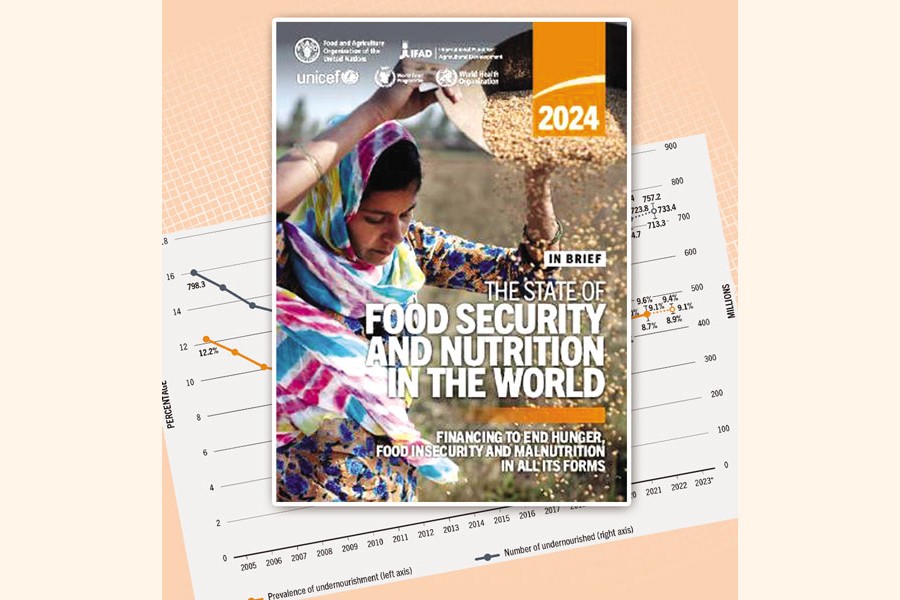
Defining hunger by a single or a set of watertight parameters is a difficult task. This is precisely because hunger varies from place to place not because of the degree but the peculiarities that essentially characterise it. More complex is tracing the exact nature of hunger at a certain geographic location and trying to correlate it with another, although apparently the symptoms may be largely common. There are a host of economic issues intricately tied to the particular state of food deficiency, and attempting to make a list of those in a sweeping manner may sometimes be misleading.
There is a debate over the methods employed by the FAO (United Nations Food and Agriculture Organisation) in calculating the number of hungry people in the world published in its annual report. The report calculates that a total of 842 million or 12 per cent of the world's population are experiencing chronic hunger over the past two years. Correctness of the figure and the way it has been worked out may not be satisfying to everyone, as the methodologies that may be applied in such a task are not necessarily uniform. Hunger, food insecurity, undernourishment are the key expressions used interchangeably. Of these, undernourishment figures are the main indicator to calculate the numbers. Questions have been raised about how the indicator is constructed, and how it is used and who uses it to measure hunger at a single point in time and to track trends over time.
There are diverse opinions in establishing or discarding the rationale based on the notion of under-nourishment. Chronic undernourishment, as defined by the FAO, is inadequate calorie intake lasting more than a year. The estimate is based on minimal calorie requirements impeding a population to be engaged in physically active lifestyle. Economists and researchers have raised questions that this threshold and the definition of undernourishment, lasting for at least a year, does not lead to an inclusive approach as it leaves out vast numbers of people across the globe who may be suffering from extreme hunger for shorter periods of time due to, say, bad harvest, flooding of croplands or sudden hike in prices or any other unforeseen political or economic turmoil. This no doubt calls for a major change in the data collection methods in order to arrive at a more acceptable mechanism to actually assess the nature of hunger and its scale. More important perhaps is the need to look at the issue not from a too generalised global perspective, but preferably on regional basis in order to understand the actual threats of hunger and come up with remedies.
The common method of presenting the global hunger phenomenon is through the scale of different dimensions of food security: food availability, economic and physical access to food, and food utilisation and stability over time. Each of these dimensions is measured by specific indicators, like the percentage of stunted children, reliance on cereals, food price volatility, average protein supply, number of roads, quality of water sources and political stability.
Critics, on the other hand, have found serious lacuna in the methodology in as much as it does not capture the effects of food price surges and other vulnerability shocks. One of the dissident scholars Ellen Messer, of the Friedman School of Nutrition and Science Policy at Tufts University, has mentioned that the FA0 methodology of measuring hunger does not explore the dynamics connecting the various strands that influence food insecurity, which is a "continuing challenge". Food programmes, according to Messer, are not the only response to address stunting in all situations. Stunting is also not a very common symptom of undernourishment in many regions, especially in Africa. FAO has not managed to 'produce comprehensive case studies analysing all current food insecurity dimensions or longer-term outlooks for all countries', says Messer.
Critics have mentioned that there are other issues the FAO should analyse so that donors, social groups, non-government organisations as well as the government can keep in mind to address. One such issue is urban hunger and its importance in relation to rural hunger. Similarly, analysing gender dimension should also figure prominently in presenting a comprehensive picture.
It is pertinent in this context to refer to the Global Hunger Index (GHI), which is designed to measure and track hunger globally, and by country and region. Calculated each year by the International Food Policy Research Institute (IFPRI), the GHI highlights successes and failures in hunger reduction and provides insights into the root causes of hunger. By raising awareness and understanding of regional and country-specific characteristics of hunger, the GHI aims to suggest actions in the medium and long terms. One of the important findings of GHI that has drawn attention of many is hidden hunger, which affects some 2.0 billion people around the world annually. Hidden hunger is believed to weaken the immune system, stunt physical and intellectual growth, and can lead to death. It wreaks economic havoc as well, locking countries into cycles of poor nutrition, lost productivity, poverty, and reduced economic growth. Possible solutions to hidden hunger include food-based approaches that will require long-term, sustained, and coordinated efforts to make a lasting difference. Hidden hunger may in other words be seen as emerging from chronic malnutrition in most of the developing world.
Thus, measuring hunger by some specific parameters is not always helpful. While addressing the drivers of hunger is important, equally important is to deal with the hidden hunger looming over the earth in varying shapes and dimensions.
wasiahmed.bd@gmail.com
© 2025 - All Rights with The Financial Express
